Comprehensive Evaluation of Cultivated Land Quality in Black Soil of Northeast China: Emphasizing Functional Diversity and Risk Management
Abstract
1. Introduction
2. Materials and Methods
2.1. Overview of the Research Area
2.2. Data Sources and Processing
2.3. Research Framework
2.4. Indicator System Construction
2.5. Indicator Weight Determination and Calculation of Comprehensive Index
3. Results and Analysis
3.1. Evaluation Results of Cultivated Land Quality Based on Cultivated Land Function
3.2. Evaluation Results of Cultivated Land Quality Based on Degradation Risk
3.3. Comprehensive Evaluation Results of Cultivated Land Quality
4. Discussion
4.1. Comprehensive Analysis of Evaluation Results
4.2. Trade-Offs and Synergies of Cultivated Land Functions
4.3. Analysis of Cultivated Land Degradation Risks
5. Conclusions
Author Contributions
Funding
Institutional Review Board Statement
Informed Consent Statement
Data Availability Statement
Conflicts of Interest
References
- FAO. Global Status of Black Soils. Rome. 2022. Available online: https://doi.org/10.4060/cc3124en (accessed on 25 November 2023).
- Sorokin, A.; Owens, P.; Láng, V.; Jiang, Z.-D.; Michéli, E.; Krasilnikov, P. “Black soils” in the Russian Soil Classification system, the US Soil Taxonomy and the WRB: Quantitative correlation and implications for pedodiversity assessment. Catena 2021, 196, 104824. [Google Scholar] [CrossRef]
- Han, X.; Zou, W.; Yang, F. Main achievements, challenges, and recommendations of black soil conservation and utilization in China. Bull. Chin. Acad. Sci. 2021, 36, 1194–1202. [Google Scholar] [CrossRef]
- Wang, M.; Liu, X.; Liu, Z.; Wang, F.; Li, X.; Hou, G.; Zhao, S. Evaluation and driving force analysis of cultivated land quality in black soil region of Northeast China. Chin. Geogr. Sci. 2023, 33, 601–615. [Google Scholar] [CrossRef]
- Ren, S.; Song, C.; Ye, S.; Cheng, F. Land use evaluation considering soil properties and agricultural infrastructure in black soil region. Land Degrad. Dev. 2023, 34, 5373–5388. [Google Scholar] [CrossRef]
- Li, X.; Wang, D.; Ren, Y.; Wang, Z.; Zhou, Y. Soil quality assessment of croplands in the black soil zone of Jilin Province, China: Establishing a minimum data set model. Ecol. Indic. 2019, 107, 105251. [Google Scholar] [CrossRef]
- Li, J.; Guo, H.; Shi, C. Evaluation method of new cultivated land quality in Guanzhong Plain of Shaanxi Province: Taking Longting Town land consolidation project as an example. IOP Conf. Ser. Earth Environ. Sci. 2018, 185, 012024. [Google Scholar] [CrossRef]
- Qian, F.; Xiang, Z.; Wang, H.; Gu, H. Evaluating cultivated land quality in county territory using the minimum data set, land evaluation and site assessment (LESA). Trans. Chin. Soc. Agric. Eng. 2023, 39, 239–248. [Google Scholar] [CrossRef]
- Xu, Y.; Pei, J.; Li, S.; Zou, H.T.; Wang, J.K.; Zhang, J.B. Main characteristics and utilization countermeasures for black soils in different regions of Northeast China. Chin. J. Soil Sci. 2023, 54, 495–504. [Google Scholar] [CrossRef]
- Qiu, S.; Hao, X.; Zhao, S.; Xu, X.; Wang, X.; He, P.; Zhou, W. Causes of fertility decline and countermeasures for protection and utilization of upland black soil—An analysis from the perspective of nutrient resources high-efficient utilization. J. Plant Nutr. Fert. 2025, 31, 1–11. [Google Scholar] [CrossRef]
- Geng, J.; Tan, Q.; Lv, J.; Fang, H. Assessing spatial variations in soil organic carbon and C:N ratio in Northeast China’s black soil region: Insights from Landsat-9 satellite and crop growth information. Soil Tillage Res. 2024, 235, 105897. [Google Scholar] [CrossRef]
- Gu, Z.; Xie, Y.; Gao, Y.; Ren, X.; Cheng, C.; Wang, S. Quantitative assessment of soil productivity and predicted impacts of water erosion in the black soil region of Northeastern China. Sci. Total Environ. 2018, 637–638, 706–716. [Google Scholar] [CrossRef]
- McBratney, A.; Field, D.; Koch, A. The dimensions of soil security. Geoderma 2014, 213, 203–213. [Google Scholar] [CrossRef]
- Wang, L.; Tian, Y.; Yao, X.; Zhu, Y.; Cao, W. Predicting grain yield and protein content in wheat by fusing multi-sensor and multi-temporal remote-sensing images. Field Crops Res. 2014, 164, 178–188. [Google Scholar] [CrossRef]
- Liu, Y.; Zhang, Y.; Guo, L. Towards realistic assessment of cultivated land quality in an ecologically fragile environment: A satellite imagery-based approach. Appl. Geogr. 2010, 30, 271–281. [Google Scholar] [CrossRef]
- Moebius-Clune, B.; Moebius-Clune, D.; Gugino, B.; Idowu, O.J.; Schindelbeck, R.R.; Ristow, A.J.; van Es, H.M.; Thies, J.E.; Shayler, H.A.; McBride, M.B.; et al. Comprehensive Assessment of Soil Health; Cornell University: Geneva, Switzerland, 2016; pp. 1–18. [Google Scholar]
- Huffman, E.; Eilers, R.; Padbury, G.; Wall, G.; MacDonald, K. Canadian agri-environmental indicators related to land quality: Integrating census and biophysical data to estimate soil cover, wind erosion and soil salinity. Agric. Ecosyst. Environ. 2000, 81, 113–123. [Google Scholar] [CrossRef]
- Van Beek, C.; Tóth, G. Risk assessment methodologies of soil threats in europe. In JRC Scientific and Policy Reports; EUR 24097; European Commission: Brussels, Belgium, 2012; p. 24097. [Google Scholar] [CrossRef]
- Mueller, L.; Schindler, U.; Shepherd, T.G.; Ball, B.C.; Smolentseva, E.; Pachikin, K.; Hu, C.; Hennings, V.; Sheudshen, A.K.; Behrendt, A.; et al. The Muencheberg Soil Quality Rating (SQR); ZALF—Leibniz Centre for Agricultural Landscape Research: Müncheberg, Germany, 2007. [Google Scholar]
- Bünemann, E.; Bongiorno, G.; Bai, Z.; Creamer, R.; Brussaard, L. Soil quality—A critical review. Soil Biol. Biochem. 2018, 120, 105–125. [Google Scholar] [CrossRef]
- Wu, F.; Mo, C.; Dai, X.; Li, H. Spatial analysis of cultivated land productivity, site condition and cultivated land health at county scale. Int. J. Environ. Res. Public Health 2022, 19, 12266. [Google Scholar] [CrossRef]
- Su, H.; Wu, C. Diagnosis and evolution characteristics of cultivated land system health condition in the Black Soil Region of Northeast China: A case study of Keshan County. Econ. Geogr. 2023, 6, 166–175. [Google Scholar] [CrossRef]
- Sui, H.; Song, G. Spatial and temporal differentiation of cultivated land quality degradation in a typical black soil region of Northeast China from the perspective of genetics and variation: A case study in Fujin City. China Land Sci. 2022, 36, 53–62. [Google Scholar] [CrossRef]
- Tang, H.; Niu, J.; Niu, Z.; Liu, Q.; Huang, Y.; Yun, W.; Shen, C.; Huo, Z. System cognition and analytic technology of cultivated land quality from a data perspective. Land 2023, 12, 237. [Google Scholar] [CrossRef]
- Zhao, R.; Wu, K.; Li, X.; Gao, N.; Yu, M. Discussion on the unified survey and evaluation of cultivated land quality at county scale for China’s 3rd National Land Survey: A case study of Wen County, Henan Province. Sustainability 2021, 13, 2513. [Google Scholar] [CrossRef]
- Song, W.; Zhang, H.; Zhao, R.; Wu, K.; Li, X.; Niu, B.; Li, J. Study on cultivated land quality evaluation from the perspective of farmland ecosystems. Ecol. Indic. 2022, 139, 108959. [Google Scholar] [CrossRef]
- Zhou, W.; Liu, Q.; Huang, Y. Deepening the cognition of black soil cultivated land quality and strengthening the evaluation and monitoring of cultivated land quality. Agric. Compr. Dev. China 2022, 11, 15–18. [Google Scholar]
- TD/T 1005-2003; Regulations for Classification on Agricultural Land. Standards Press of China: Beijing, China, 2003. Available online: https://www.nssi.org.cn/nssi/front/12452770 (accessed on 25 November 2023).
- TD/T 1055-2019; Technical Regulation of the Third Nationwide Land Survey. Standards Press of China: Beijing, China, 2019. Available online: https://www.nssi.org.cn/nssi/front/108831133 (accessed on 28 November 2023).
- Rutgers, M.; Mulder, C.; Schouten, A. Soil Ecosystem Profiling in the Netherlands with Ten References for Soil Biological Quality; RIVM Report 607604009/2008; RIVM: Bilthoven, The Netherlands, 2008. [Google Scholar]
- Blagodatskaya, E.; Kuzyakov, Y. Active microorganisms in soil: Critical review of estimation criteria and approaches. Soil Biol. Biochem. 2013, 67, 192–211. [Google Scholar] [CrossRef]
- Yao, D.; Pei, J.; Wang, J. Temporal-spatial changes in cultivated land quality in a black soil region of Northeast China. Chin. J. Eco-Agric. 2020, 28, 104–114. [Google Scholar] [CrossRef]
- Han, X.; Zou, W. Effects and suggestions of black soil protection and soil fertility increase in Northeast China. Bull. Chin. Acad. Sci. 2018, 33, 206–212. [Google Scholar] [CrossRef]
- Meng, X.; Wang, H. Soil Map Based Harmonized World Soil Database (v1.2). In A Big Earth Data Platform for Three Poles; National Tibetan Plateau/Third Pole Environment Data Center: Beijing, China, 2018. [Google Scholar]
- Di Gregorio, A.; Jansen, L. Land Cover Classification System (LCCS): Classification Concepts and User Manual; FAO: Rome, Italy, 1998. [Google Scholar]
- Zhang, F.; An, P.; Wang, J.; Zhang, J.; Liu, L.; Chen, H. Soil quality criteria and methodologies of farmland grading. Resour. Sci. 2002, 24, 71–75. [Google Scholar] [CrossRef]
- Yun, W. Problems and countermeasures in the development and utilization of cultivated land resource in China. Bull. Chin. Acad. Sci. 2015, 30, 484–491. [Google Scholar] [CrossRef]
- Legaz, B.V.; De Souza, D.M.; Teixeira, R.; Antón, A.; Putman, B.; Sala, S. Soil quality, properties, and functions in life cycle assessment: An evaluation of models. J. Clean. Prod. 2017, 140, 502–515. [Google Scholar] [CrossRef]
- Kong, X.; Zhang, B.; Wen, L.; Hu, Y.; Lei, M.; Yao, J.; Xin, Y. Theoretical framework and research trends of cultivated land quality based on elements-process-function. China Land Sci. 2018, 32, 14–20. [Google Scholar]
- Deng, X.; Xu, X.; Wang, S. The tempo-spatial changes of soil fertility in farmland of China from the 1980s to the 2010s. Ecol. Indic. 2023, 146, 109913. [Google Scholar] [CrossRef]
- Li, C.; Wu, J. Land use transformation and eco-environmental effects based on production-living-ecological spatial synergy: Evidence from Shaanxi Province, China. Environ. Sci. Pollut. Res. 2022, 29, 41492–41504. [Google Scholar] [CrossRef]
- Kou, X.; Tao, Y.; Wang, S.; Wu, Z.; Wu, H.; He, H. How soil meso-/macro-faunas orchestrate ecosystem multifunctionality under different artificial disturbance conditions in the Changbai Mountain region, China. Land Degrad. Dev. 2022, 33, 3438–3445. [Google Scholar] [CrossRef]
- Wang, H.; Yang, S.; Wang, Y.; Gu, Z.; Xiong, S.; Huang, X.; Sun, M.; Zhang, S.; Guo, L.; Cui, J.; et al. Rates and causes of black soil erosion in Northeast China. Catena 2022, 214, 106250. [Google Scholar] [CrossRef]
- Nawaz, M.; Bourrie, G.; Trolard, F. Soil compaction impact and modelling: A review. Agron. Sustain. Dev. 2013, 33, 291–309. [Google Scholar] [CrossRef]
- Raza, S.; Miao, N.; Wang, P.; Ju, X.; Chen, Z.; Zhou, J.; Kuzyakov, Y. Dramatic loss of inorganic carbon by nitrogen-induced soil acidification in Chinese croplands. Glob. Change Biol. 2020, 26, 3738–3751. [Google Scholar] [CrossRef]
- Xie, Y.; Lin, H.; Ye, Y.; Ren, X. Changes in soil erosion in cropland in northeastern China over the past 300 years. Catena 2019, 176, 410–418. [Google Scholar] [CrossRef]
- Wu, H.; Wang, S.; Huai, S.; Yan, Z.; Ma, C.; Xue, Y.; Xu, M.; Lu, C. Evolutionary characteristics of fertility and productivity of typical black soil in recent 30 years. J. Plant Nutr. Fert. 2018, 24, 1456–1464. [Google Scholar] [CrossRef]
- Liu, X.; Qiao, G.; Guo, F.; Liu, D.; Li, Y.; Gou, Y.; Yu, R.; Zhou, W.; Huang, Y. Evaluation and obstacle analysis of cultivated horizon soil quality based on MDS in the dry farming areas of Huang-Huai-Hai Region. Trans. Chin. Soc. Agric. Eng. 2023, 39, 104–113. [Google Scholar] [CrossRef]
- Wu, C.; Liu, G.; Ma, G.; Liu, Q.; Yu, F.; Huang, C.; Zhao, Z.; Liang, L. Study of the differences in soil properties between the dry season and rainy season in the Mun River Basin. Catena 2019, 182, 104103. [Google Scholar] [CrossRef]
- Joss, B.N.; Hall, R.J.; Sidders, D.M.; Keddy, T. Fuzzy-logic modeling of land suitability for hybrid poplar across the Prairie Provinces of Canada. Environ. Monit. Assess. 2008, 141, 79–96. [Google Scholar] [CrossRef] [PubMed]
- Baja, S.; Chapman, D.; Dragovich, D. A conceptual model for defining and assessing land management units using a fuzzy modeling approach in GIS environment. Environ. Manag. 2002, 29, 647–661. [Google Scholar] [CrossRef]
- Ozdemir, M.S. Validity and inconsistency in the analytic hierarchy process. Appl. Math. Comput. 2005, 161, 707–720. [Google Scholar] [CrossRef]
- Yu, G.; Feng, J.; Che, Y.; Lin, X.; Hu, L.; Yang, S. The identification and assessment of ecological risks for land consolidation based on the anticipation of ecosystem stabilization: A case study in Hubei Province, China. Land Use Policy 2010, 27, 293–303. [Google Scholar] [CrossRef]
- Doran, J.W.; Coleman, D.C.; Bezdicek, D.F.; Stewart, B.A.; Haynes, R.J. Defining soil quality for a sustainable environment. In Soil Science Society of America Special Publication 35; Soil Science Society of America: Madison, WI, USA, 1994. [Google Scholar] [CrossRef]
- Schulte, R.P.; Creamer, R.E.; Donnellan, T.; Farrelly, N.; Fealy, R.; O’donoghue, C.; O’huallachain, D. Functional land management: A framework for managing soil-based ecosystem services for the sustainable intensification of agriculture. Environ. Sci. Policy 2014, 38, 45–58. [Google Scholar] [CrossRef]
- Barrios, E. Soil biota, ecosystem services and land productivity. Ecol. Econ. 2007, 64, 269–285. [Google Scholar] [CrossRef]
- Ministry of Agriculture and Rural Affairs. Bulletin of the Ministry of Agriculture and Rural Affairs of the People’s Republic of China on Farmland Quality Grades in 2019. (Bulletin of Ministry of Agriculture and Rural Affairs [2020] (No.1) [EB/0L]. Available online: https://www.gov.cn/xinwen/2020-05/13/content_5511129.htm. (accessed on 12 October 2023).
- Qian, F.; Chi, Y.; Xu, H. Study on evolution of trade-off and synergy relationship of multifunctional cultivated land from 2006 to 2020: A case study of Shenyang City. China Land Sci. 2022, 36, 31–41. [Google Scholar]
- Zhang, Y.; Dai, Y.; Chen, Y.; Ke, X. Spatial-temporal evolution and driving factors of cultivated land multifunctional coupling coordination development in China. Trans. Chin. Soc. Agric. Eng. 2023, 39, 244–255. [Google Scholar] [CrossRef]
- Han, X.; Zou, W.; Yan, J.; Li, N.; Li, Y.; Wang, J.; Li, L. Ecology in agriculture and long-term research guide protection of black soil and agricultural sustainable development in Northeast China. Bull. Chin. Acad. Sci. 2019, 34, 362–370. [Google Scholar] [CrossRef]
- Suxia, L.; Li, Z.; Wang, B. Trade-off and synergy relationships and regional regulation of multifunctional cultivated land in Henan Province. Trans. Chin. Soc. Agric. Mach. 2024, 55, 363–374. [Google Scholar]
- Liu, Y.; Wan, C.; Xu, G.; Chen, L.; Yang, C. Exploring the relationship and influencing factors of cultivated land multifunction in China from the perspective of trade-off/synergy. Ecol. Indic. 2023, 149, 110171. [Google Scholar] [CrossRef]
- Xin, J.; Wang, J.; Xue, Y. Evaluation of Cultivated Land Quality in the Black Soil Region of Northeast China; China Agriculture Press: Beijing, China, 2017. [Google Scholar]
- Xu, X.Z.; Xu, Y.; Chen, S.C.; Xu, S.G.; Zhang, H.W. Soil loss and conservation in the black soil region of Northeast China: A retrospective study. Environ. Sci. Policy 2010, 13, 793–800. [Google Scholar] [CrossRef]
- Ao, M.; Zhang, X.; Guan, Y. Research and practice of conservation tillage in black soil region of Northeast China. Bull. Chin. Acad. Sci. 2021, 36, 1203–1215. [Google Scholar] [CrossRef]
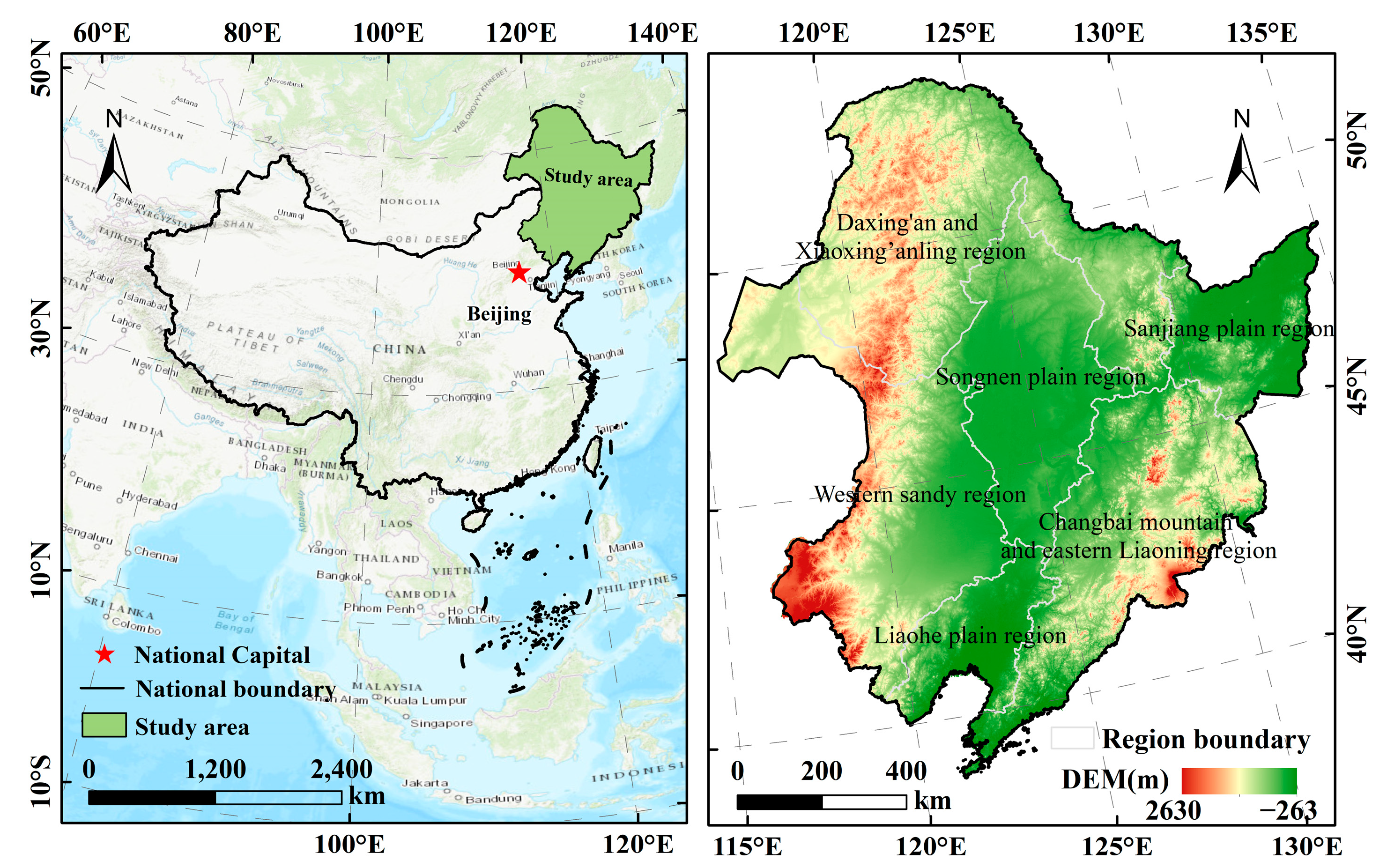
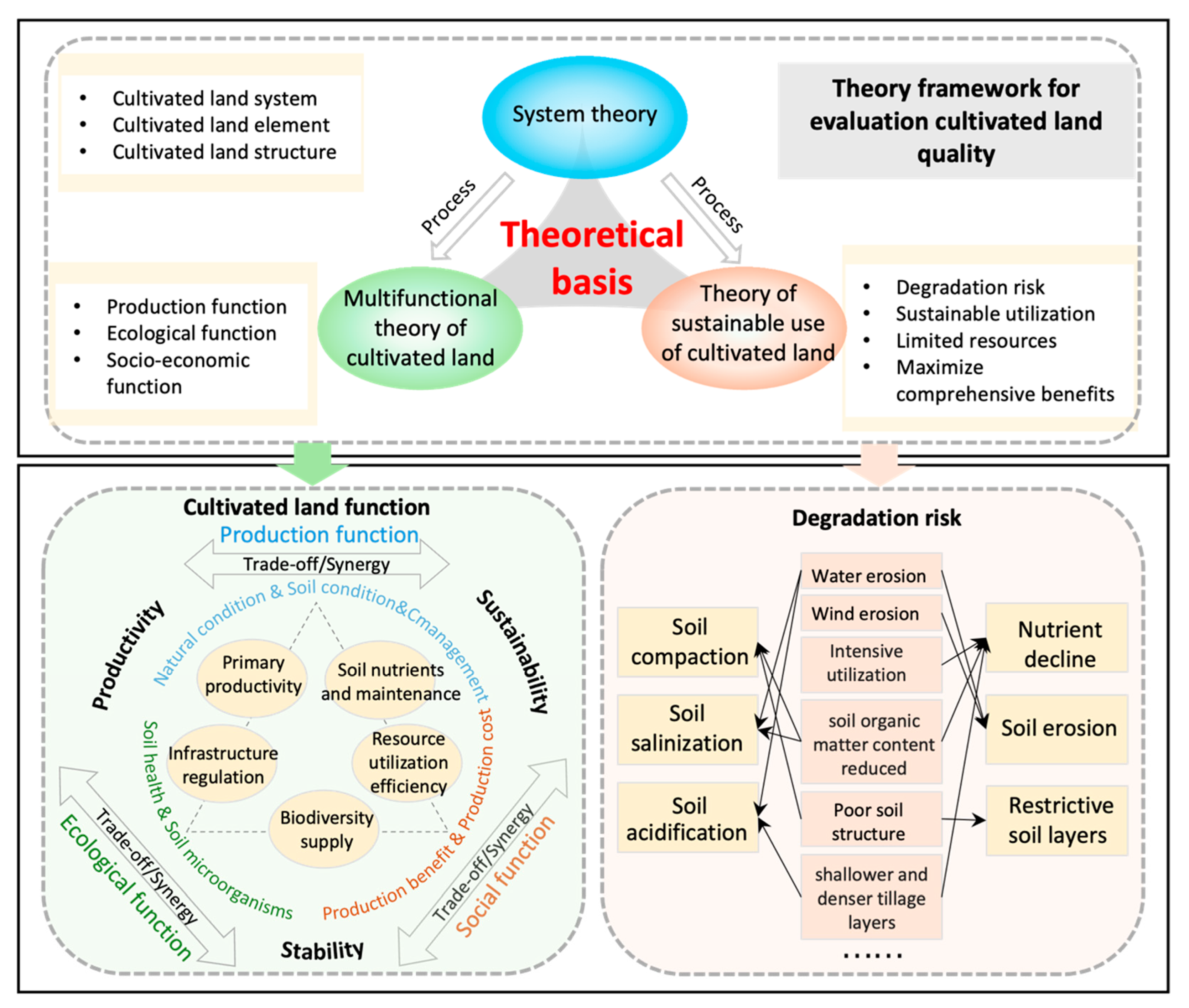

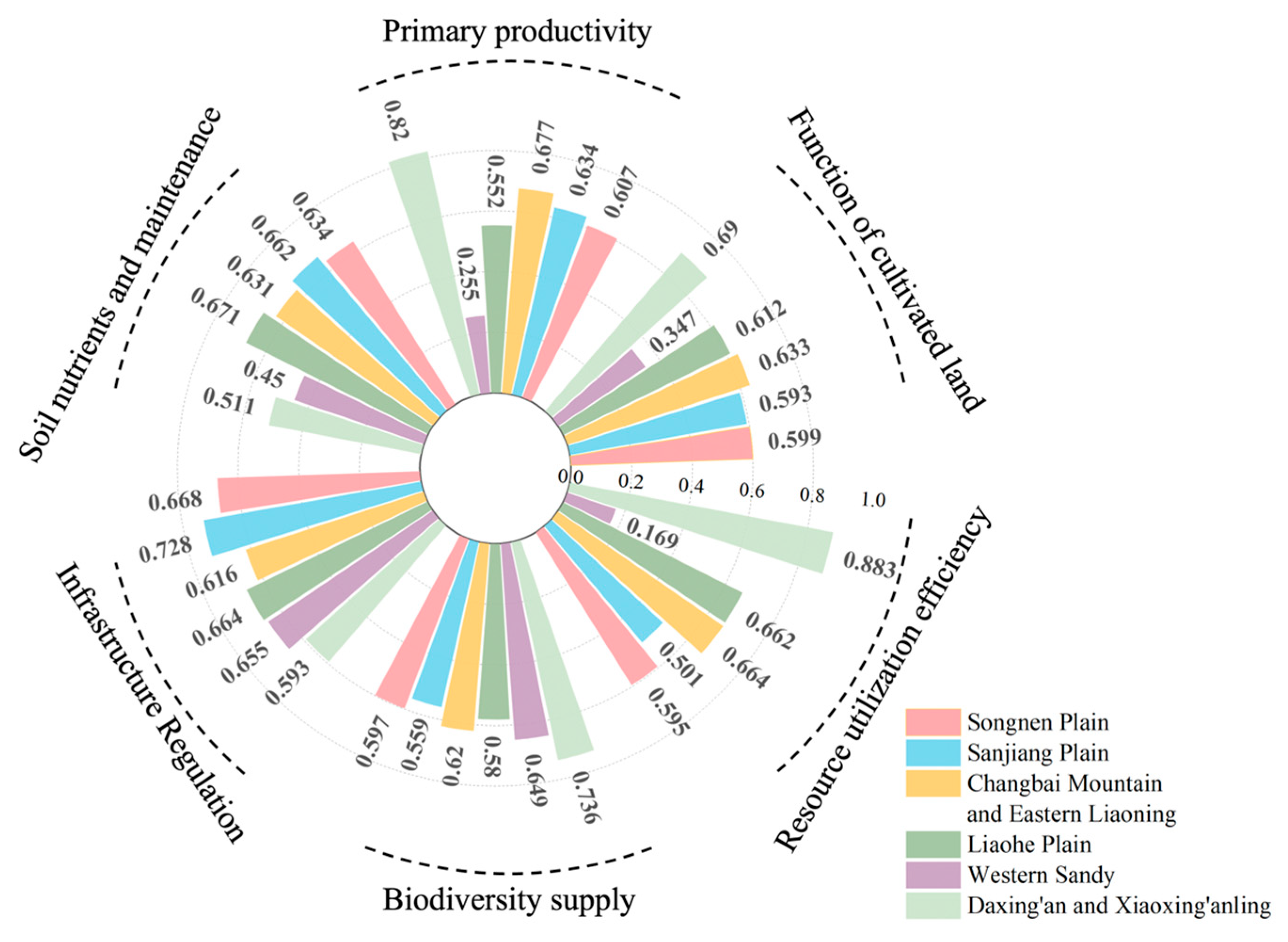

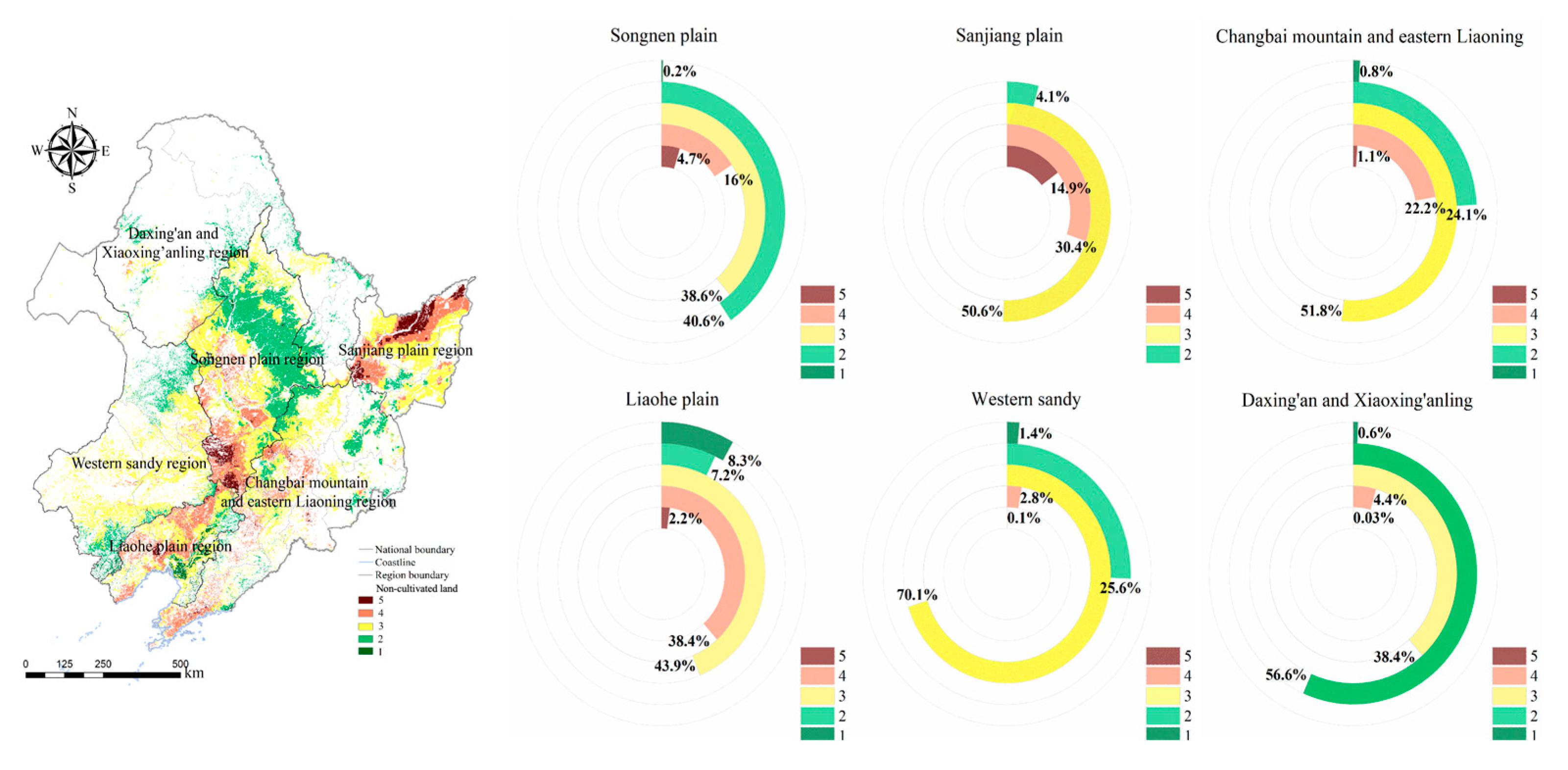
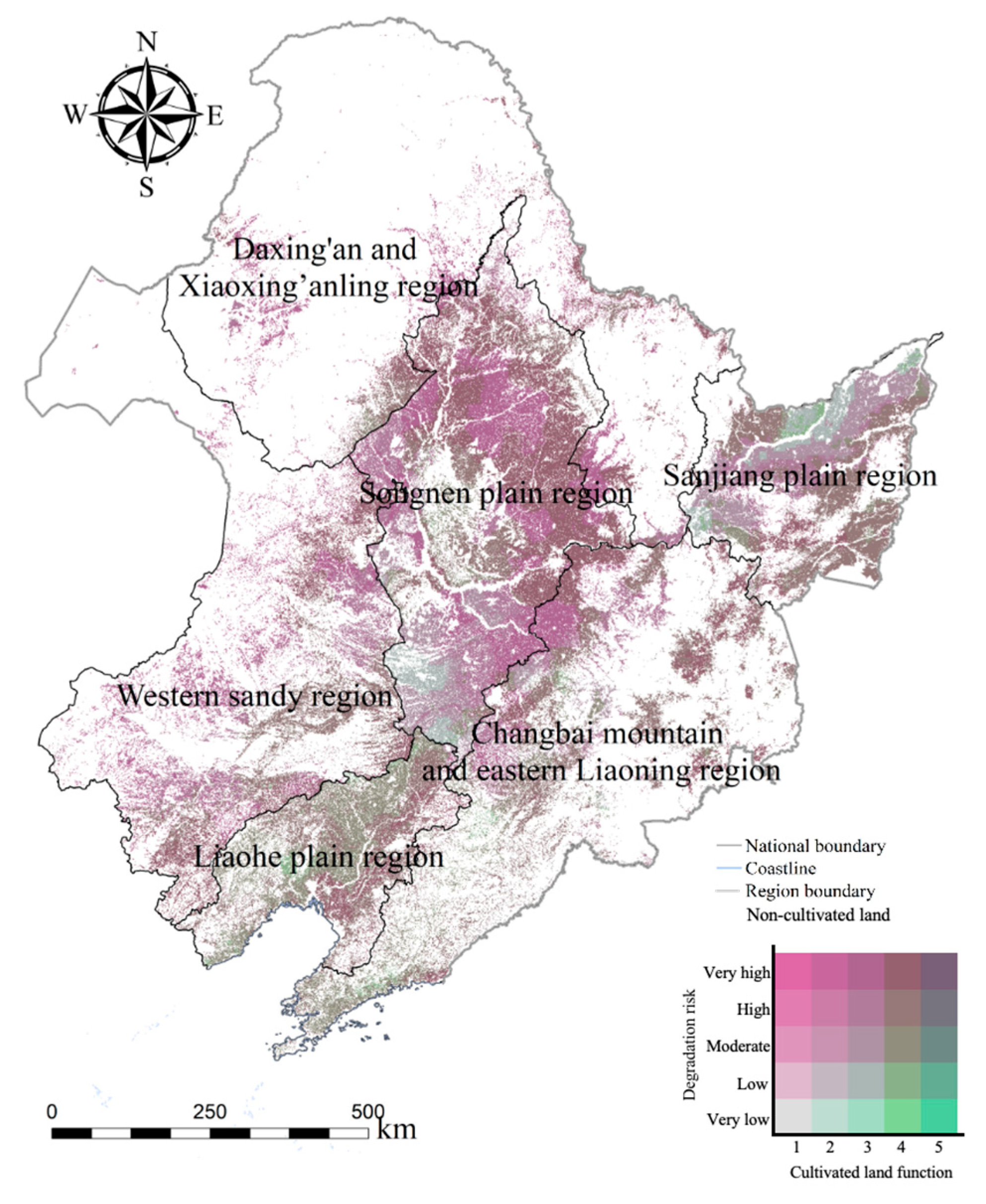

| Criterion Layer | Indicator Layer | Unit | Source | Scale/Sample Size | |
|---|---|---|---|---|---|
| Production function | Primary productivity | Accumulated temperature | °C | https://data.cma.cn/ (accessed on 12 October 2023) | 500 m × 500 m |
| Average annual precipitation | mm | https://www.resdc.cn/DOI/ (accessed on 10 October 2023) | 1 km × 1 km | ||
| Altitude | m | https://www.gscloud.cn/ (accessed on 10 October 2023) | 30 m × 30 m | ||
| Soil nutrients and maintenance | Soil texture | - | Third National Land Survey Point Data | 1878 points | |
| Soil organic matter | g/kg | Third National Land Survey Point Data | 1878 points | ||
| Infrastructure regulation | Effective soil depth | cm | Basic Soil Property Dataset of High-Resolution China Soil Information Grids (2010–2018) | 1 km × 1 km | |
| Irrigation capacity | % | Third National Land Survey Point Data | 1878 points | ||
| Drainage capacity | m/ acre | Survey and Evaluation Sample Data on Cultivated Land Quality in Various Counties and Districts in Northeast China (2021) | 10,583 points | ||
| Field shelterbelt ratio | % | https://www.zgtjnj.org/navibooklist-n3023062107-1.html (accessed on 12 October 2023) | city | ||
| Ecological function | Biodiversity supply | Soil biodiversity level | - | Third National Land Survey Point Data | 1878 points |
| Social function | Resource utilization efficiency | Per-acre production cost | - | Ministry of Agriculture’s Report on the http://www.njhs.moa.gov.cn/nyjxhqk/202209/t20220919_6409640.htm (accessed on 12 October 2023) | province |
| Degradation risk | Nutrient decline | Organic matter content change | g/kg | Third National Land Survey Point Data | 1878 points |
| Soil erosion | Black soil layer thickness | cm | https://www.isric.org/explore/soilgrids/ 15 October 2023 (accessed on 12 October 2023) | - | |
| Restrictive soil layers | Position of the albic layer | cm | Information obtained through searching | - | |
| Thickness of the albic layer | cm | Information obtained through searching | - | ||
| Soil salinization | Sodium alkalinity | % | Soil Map-Based Harmonized World Soil Database (v1.2) | 1 km × 1 km | |
| Soil acidification | Soil pH | - | Basic Soil Property Dataset of High-Resolution China Soil Information Grids (2010–2018) | 1 km × 1 km | |
| Soil compaction | Soil bulk density | g/cm3 | Basic Soil Property Dataset of High-Resolution China Soil Information Grids (2010–2018) | 1 km × 1 km |
| Cultivated Land Function | Indicator | Weight |
|---|---|---|
| Primary productivity | Accumulated temperature | 0.1098 |
| Average annual precipitation | 0.1258 | |
| Altitude | 0.0867 | |
| Soil nutrients and maintenance | Soil texture | 0.1621 |
| Soil organic matter | 0.0706 | |
| Infrastructure Regulation | Effective soil depth | 0.1086 |
| Irrigation capacity | 0.0489 | |
| Drainage capacity | 0.0768 | |
| Field shelterbelt ratio | 0.0789 | |
| Biodiversity supply | Soil biodiversity level | 0.0630 |
| Resource utilization efficiency | Per-acre production cost | 0.0688 |
| Grade 5 (m2) | Grade 4 (m2) | Grade 3 (m2) | Grade 2 (m2) | Grade 1 (m2) | |
|---|---|---|---|---|---|
| Primary productivity | 287 | 9675 | 131,200 | 231,401 | 7838 |
| Soil nutrients and maintenance | 0 | 0 | 37,259 | 339,022 | 3104 |
| Infrastructure regulation | 0 | 954 | 181,925 | 184,377 | 12,321 |
| Biodiversity supply | 41,649 | 153,280 | 99,451 | 73,693 | 13,488 |
| Resource utilization efficiency | 32,868 | 15,586 | 51,882 | 123,630 | 157,301 |
| Very High (m2) | High (m2) | Moderate (m2) | Low (m2) | Very Low (m2) | |
|---|---|---|---|---|---|
| Songnen Plain | 19 | 4467 | 14,844 | 35,982 | 64,812 |
| Sanjiang Plain | 0 | 7057 | 16,218 | 30,827 | 3321 |
| Changbai Mountain and Eastern Liaoning | 0 | 1209 | 14,515 | 36,398 | 18,058 |
| Liaohe Plain | 2 | 1283 | 18,548 | 15,507 | 6506 |
| Western Sandy | 2 | 35 | 752 | 30,302 | 31,875 |
| Daxing’an and Xiaoxing’anling | 0 | 5 | 610 | 6741 | 20,767 |
Disclaimer/Publisher’s Note: The statements, opinions and data contained in all publications are solely those of the individual author(s) and contributor(s) and not of MDPI and/or the editor(s). MDPI and/or the editor(s) disclaim responsibility for any injury to people or property resulting from any ideas, methods, instructions or products referred to in the content. |
© 2025 by the authors. Licensee MDPI, Basel, Switzerland. This article is an open access article distributed under the terms and conditions of the Creative Commons Attribution (CC BY) license (https://creativecommons.org/licenses/by/4.0/).
Share and Cite
Tang, H.; Zhang, Y.; Liu, Q.; Guo, M.; Niu, J.; Xia, Q.; Liang, M.; Liu, Y.; Huang, Y.; Du, Y. Comprehensive Evaluation of Cultivated Land Quality in Black Soil of Northeast China: Emphasizing Functional Diversity and Risk Management. Appl. Sci. 2025, 15, 3753. https://doi.org/10.3390/app15073753
Tang H, Zhang Y, Liu Q, Guo M, Niu J, Xia Q, Liang M, Liu Y, Huang Y, Du Y. Comprehensive Evaluation of Cultivated Land Quality in Black Soil of Northeast China: Emphasizing Functional Diversity and Risk Management. Applied Sciences. 2025; 15(7):3753. https://doi.org/10.3390/app15073753
Chicago/Turabian StyleTang, Huaizhi, Yuanyuan Zhang, Qi Liu, Mengyu Guo, Jiacheng Niu, Qiuyue Xia, Mengyin Liang, Yunjia Liu, Yuanfang Huang, and Yamin Du. 2025. "Comprehensive Evaluation of Cultivated Land Quality in Black Soil of Northeast China: Emphasizing Functional Diversity and Risk Management" Applied Sciences 15, no. 7: 3753. https://doi.org/10.3390/app15073753
APA StyleTang, H., Zhang, Y., Liu, Q., Guo, M., Niu, J., Xia, Q., Liang, M., Liu, Y., Huang, Y., & Du, Y. (2025). Comprehensive Evaluation of Cultivated Land Quality in Black Soil of Northeast China: Emphasizing Functional Diversity and Risk Management. Applied Sciences, 15(7), 3753. https://doi.org/10.3390/app15073753







